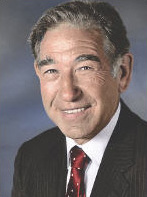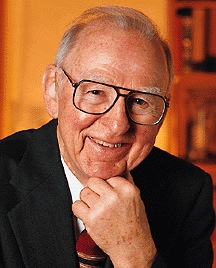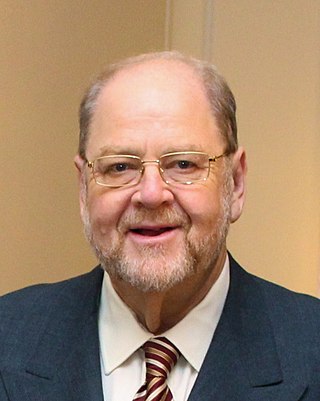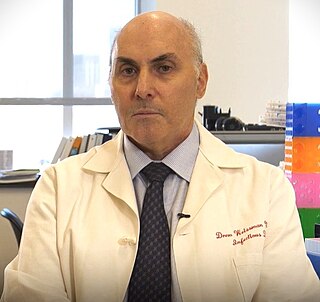
Stanley Ben Prusiner is an American neurologist and biochemist. He is the director of the Institute for Neurodegenerative Diseases at University of California, San Francisco (UCSF). Prusiner discovered prions, a class of infectious self-reproducing pathogens primarily or solely composed of protein. He received the Albert Lasker Award for Basic Medical Research in 1994 and the Nobel Prize in Physiology or Medicine in 1997 for prion research developed by him and his team of experts beginning in the early 1970s.

Bengt Ingemar Samuelsson is a Swedish biochemist. He shared with Sune K. Bergström and John R. Vane the 1982 Nobel Prize for Physiology or Medicine for discoveries concerning prostaglandins and related substances.

Bert Sakmann is a German cell physiologist. He shared the Nobel Prize in Physiology or Medicine with Erwin Neher in 1991 for their work on "the function of single ion channels in cells," and the invention of the patch clamp. Bert Sakmann was Professor at Heidelberg University and is an Emeritus Scientific Member of the Max Planck Institute for Medical Research in Heidelberg, Germany. Since 2008 he leads an emeritus research group at the Max Planck Institute of Neurobiology.

Stanley Cohen was an American biochemist who, along with Rita Levi-Montalcini, was awarded the Nobel Prize in Physiology or Medicine in 1986 for the isolation of nerve growth factor and the discovery of epidermal growth factor. He died in February 2020 at the age of 97.

Marshall Warren Nirenberg was an American biochemist and geneticist. He shared a Nobel Prize in Physiology or Medicine in 1968 with Har Gobind Khorana and Robert W. Holley for "breaking the genetic code" and describing how it operates in protein synthesis. In the same year, together with Har Gobind Khorana, he was awarded the Louisa Gross Horwitz Prize from Columbia University.

Erwin Neher is a German biophysicist, specializing in the field of cell physiology. For significant contribution in the field, in 1991 he was awarded, along with Bert Sakmann, the Nobel Prize in Physiology or Medicine for "their discoveries concerning the function of single ion channels in cells".
Pierre Chambon was the founder of the Institute for Genetics and Cellular and Molecular Biology in Strasbourg, France. He was one of the leading molecular biologists who utilized gene cloning and sequencing technology to first decipher the structure of eukaryotic genes and their modes of regulation. His major contributions to science include the identification of RNA polymerase II (B), the identification of transcriptional control elements, the cloning and dissection of nuclear hormone receptors, revealing their structure and showing how they contribute to human physiology. His group was also one of the first to demonstrate, biochemically and electron-microscopically, that the nucleosome is the smallest unit of chromatin. He accomplished much of his work in the 1970s – 1990s.
Ronald Mark Evans is an American Biologist, Professor and Head of the Salk’s Gene Expression Laboratory, and the March of Dimes Chair in Molecular and Developmental Biology at the Salk Institute for Biological Studies in La Jolla, California and a Howard Hughes Medical Institute Investigator. Dr. Ronald M. Evans is known for his original discoveries of nuclear hormone receptors (NR), a special class of transcriptional factor, and the elucidation of their universal mechanism of action, a process that governs how lipophilic hormones and drugs regulate virtually every developmental and metabolic pathway in animals and humans. Nowadays, NRs are among the most widely investigated group of pharmaceutical targets in the world, already yielding benefits in drug discovery for cancer, muscular dystrophies, osteoporosis, type II diabetes, obesity, and cardiovascular diseases. His current research focuses on the function of nuclear hormone signaling and their function in metabolism and cancer.

Edwin Gerhard Krebs was an American biochemist. He received the Albert Lasker Award for Basic Medical Research and the Louisa Gross Horwitz Prize of Columbia University in 1989 together with Alfred Gilman and, together with his collaborator Edmond H. Fischer, was awarded the Nobel Prize in Physiology or Medicine in 1992 for describing how reversible phosphorylation works as a switch to activate proteins and regulate various cellular processes.

James Edward Rothman is an American biochemist. He is the Fergus F. Wallace Professor of Biomedical Sciences at Yale University, the Chairman of the Department of Cell Biology at Yale School of Medicine, and the Director of the Nanobiology Institute at the Yale West Campus. Rothman also concurrently serves as adjunct professor of physiology and cellular biophysics at Columbia University and a research professor at the UCL Queen Square Institute of Neurology, University College London.
The Canada Gairdner International Award is given annually by the Gairdner Foundation at a special dinner to five individuals for outstanding discoveries or contributions to medical science. Receipt of the Gairdner is traditionally considered a precursor to winning the Nobel Prize in Medicine; as of 2020, 95 Nobel Prizes have been awarded to prior Gairdner recipients.
The Passano Foundation, established in 1945, provides an annual award to a research scientist whose work – done in the United States – is thought to have immediate practical benefits. Many Passano laureates have subsequently won the Nobel Prize.

Established in 1986, the Louis-Jeantet Prizes are funded by the Fondation Louis-Jeantet and awarded each year to experienced researchers who have distinguished themselves in the field of biomedical research in one of the member states of the Council of Europe. They are not intended solely as the recognition of work that has been completed, but also to encourage the continuation of innovative research projects. The prizes are awarded to fully active researchers whose scientific efforts are focused on biomedical research. When the research being recognised is close to practical applications for combating illnesses affecting humankind, one of the Louis-Jeantet Prizes converts into a Jeantet-Collen Prize for Translational Medicine, supported by generous donations from the Désiré Collen Stichting.
The Grande Médaille of the French Academy of Sciences, established in 1997, is awarded annually to a researcher who has contributed decisively to the development of science. It is the most prestigious of the Academy's awards, and is awarded in a different field each year. Its creation results from the combination of the original French Academy of Sciences Lalande Prize of 1802 with the Benjamin Valz Foundation Prize in 1970 and then with another 122 foundation prizes in 1997.
Bert W. O’Malley is the Tom Thompson Distinguished Service Professor of Molecular and Cellular Biology and Chancellor at Baylor College of Medicine. A native of Pittsburgh, he has a bachelor's degree from the University of Pittsburgh and a M.D. from their School of Medicine (1963). He completed his residency at Duke University and spent four years at the National Institute of Health followed by four years serving as the Luscious Birch Professor and the director of the Reproductive Biology Center at Vanderbilt University. He then moved to Baylor as Professor and Chairman of Molecular and Cellular Biology.
The Albany Medical Center Prize in Medicine and Biomedical Research is the United States' second highest value prize in medicine and biomedical research, awarded by the Albany Medical Center. Among prizes for medicine worldwide, the Albany Medical Center Prize is the fourth most lucrative.

Katalin "Kati" Karikó is a Hungarian-American biochemist who specializes in ribonucleic acid (RNA)-mediated mechanisms, particularly in vitro-transcribed messenger RNA (mRNA) for protein replacement therapy. Karikó laid the scientific groundwork for mRNA vaccines, overcoming major obstacles and skepticism in the scientific community. Karikó received the Nobel Prize in Physiology or Medicine in 2023 for her work, along with American immunologist Drew Weissman.

Drew Weissman is an American physician and immunologist known for his contributions to RNA biology. Weissman is the inaugural Roberts Family Professor in Vaccine Research, director of the Penn Institute for RNA Innovation, and professor of medicine at the Perelman School of Medicine at the University of Pennsylvania (Penn).

The 2023 Nobel Prize in Physiology or Medicine was awarded to Katalin Karikó and Drew Weissman "for their discoveries concerning nucleoside base modifications that enabled the development of effective mRNA vaccines against COVID-19".